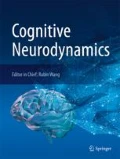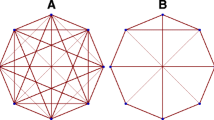Abstract
Complex neurodynamical systems are quite difficult to analyze and understand. New type of plots are introduced to help in visualization of high-dimensional trajectories and show global picture of the phase space, including relations between basins of attractors. Color recurrence plots (RPs) display distances from each point on the trajectory to all other points in a two-dimensional matrix. Fuzzy Symbolic Dynamics (FSD) plots enhance this information mapping the whole trajectory to two or three dimensions. Each coordinate is defined by the value of a fuzzy localized membership function, optimized to visualize interesting features of the dynamics, showing to which degree a point on the trajectory belongs to some neighborhood. The variance of the trajectory within the attraction basin plotted against the variance of the synaptic noise provides information about sizes and shapes of these basins. Plots that use color to show the distance between each trajectory point and a larger number of selected reference points (for example centers of attractor basins) are also introduced. Activity of 140 neurons in the semantic layer of dyslexia model implemented in the Emergent neural simulator is analyzed in details showing different aspects of neurodynamics that may be understood in this way. Influence of connectivity and various neural properties on network dynamics is illustrated using visualization techniques. A number of interesting conclusions about cognitive neurodynamics of lexical concept activations are drawn. Changing neural accommodation parameters has very strong influence on the dwell time of the trajectories. This may be linked to attention deficits disorders observed in autism in case of strong enslavement, and to ADHD-like behavior in case of weak enslavement.















Similar content being viewed by others
References
Aisa B, Mingus B, O’Reilly RC (2008) The emergent neural modeling system. Neural Netw 21(8):1146–1152
Bilder RM, Sabb FW, Cannon TD, London ED, Jentsch JD, Parker DS, Poldrack RA, Evans C, Freimer NB (2009) Phenomics: the systematic study of phenotypes on a genome-wide scale. Neuroscience 164(1):30–42
Consortium for Neuropsychiatric Phenomics (2011) http://www.phenomics.ucla.edu/
Cox TF, Cox MAA (2001) Multidimensional scaling (2nd edn). Chapman & Hall, London
Dawkins R (1989) The selfish gene (2nd edn., new ed.), Chap. 11. Memes: the new replicators. Oxford University Press, Oxford
Distin K (2005) The selfish meme: a critical reassessment. Cambridge University Press, Cambridge
Duch W (2005) Uncertainty of data, fuzzy membership functions, and multi-layer perceptrons. IEEE Trans Neural Netw 16(1):10–23
Duch W (2009) Consciousness and attention in autism spectrum disorders. In: Coma and consciousness. Clinical, societal and ethical implications. In: Satellite symposium of the 13th annual meeting of the association for the scientific studies of consciousness, Berlin, p 46
Dobosz K, Duch W (2010) Understanding neurodynamical systems via fuzzy symbolic dynamics. Neural Netw 23:487–496
Eckmann JP, Kamphorst SO, Ruelle D (1987) Recurrence plots of dynamical systems. Europhys Lett 5:973–977
Freeman W (2000) Neurodynamics: an exploration in mesoscopic brain dynamics. Springer, Berlin
Gepner B, Feron F (2009) Autism: a world changing too fast for a mis-wired brain. Neurosci Biobehav Rev 33(8):1227–1242
Hao, B, Zheng, W (eds) (1998) Applied symbolic dynamics and chaos. World Scientific, Singapore
Harth E, Tzanakou E (1974) ALOPEX: a stochastic method for determining visual receptive fields. Vis Res 14:1475–1482
Kawakubo Y, Maekawa H, Itoh K, Hashimoto O, Iwanami A (2007) Electrophysiological abnormalities of spatial attention in adults with autism during the gap overlap task. Clin Neurophysiol 118(7):1464–1471
Klir GJ, Yuan B (1995) Fuzzy sets and fuzzy logic: theory and applications. Prentice Hall, Englewood Cliffs
Landry R, Bryson SE (2004) Impaired disengagement of attention in young children with autism. J Child Psychol Psychiatry 45(6):1115–1122
Martín-Loeches M, Hinojosa JA, Fernández-Frías C, Rubia FJ (2001) Functional differences in the semantic processing of concrete and abstract words. Neuropsychologia 39(10):1086–1096
Marwan N, Romano MC, Thiel M, Kurths J (2007) Recurrence plots for the analysis of complex systems. Phys Reports 438:237–329
Marwan N, Wessel N, Meyerfeldt U, Schirdewan A, Kurths J (2002) Recurrence plot based measures of complexity and its application to heart rate variability data. Phys Rev E 66:026702
Muresan RC, Savin C (2007) Resonance or integration? Self-sustained dynamics and excitability of neural microcircuits. J Neurophysiol 97(3):1911–1930
O’Reilly RC, Munakata Y (2000) Computational explorations in cognitive neuroscience. MIT Press, Cambridge
Pinto D et al (2010) Functional impact of global rare copy number ariation in autism spectrum disorders. Nature 466:368–372
Sanei S, Chambers JA (2008) EEG signal processing. Wiley, New York
Seth AK (2008) Causal networks in simulated neural systems. Cogn Neurodyn 2:49–64
Spivey M (2007) The continuity of mind. Oxford University Press, New York
Wang J, Conder JA, Blitzer DN, Shinkareva SV (2010) Neural representation of abstract and concrete concepts: a meta-analysis of neuroimaging studies. Hum Brain Mapp 31(10):1459–1468
Webber CL Jr., Zbilut JP (1994) Dynamical assessment of physiological systems and states using recurrence plot strategies. J Appl Physiol 76:965–973
Zadeh LA (1968) Probability measures of fuzzy events. J Math Anal Appl 23:421–427
Zbilut JP, Webber CL Jr. (1992) Embeddings and delays as derived from quantification of recurrence plots. Phys Lett A 171:199–203
Zimmerman, AW (eds) (2008) Autism: current theories and evidence. Humana Press, Clifton
Acknowledgments
We are grateful for the support of the Polish Ministry of Education and Science through Grant No N519 578138.
Author information
Authors and Affiliations
Corresponding author
Rights and permissions
About this article
Cite this article
Duch, W., Dobosz, K. Visualization for understanding of neurodynamical systems. Cogn Neurodyn 5, 145–160 (2011). https://doi.org/10.1007/s11571-011-9153-1
Received:
Revised:
Accepted:
Published:
Issue Date:
DOI: https://doi.org/10.1007/s11571-011-9153-1




